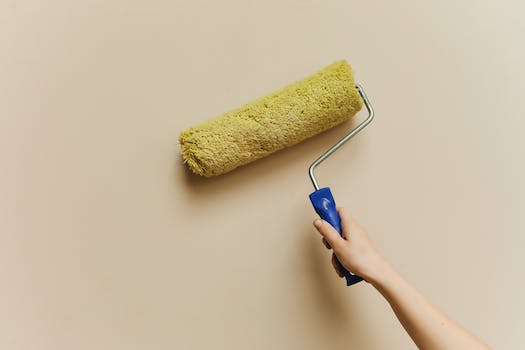Painting your walls can be a fun and creative way to transform any room in your home. With the right techniques and some helpful tips and tricks, you can easily create stylish and unique walls that will make a statement. In this article, we will explore some of the best ways to use paint to create stunning walls that will leave a lasting impression on anyone who sees them.
- 1. Preparation
- 1.1. Clean the walls
- 1.2. Fill any holes or cracks
- 1.3. Sand the walls
- 1.4. Prime the walls
- 1.5. Tape off any trim or areas you don’t want painted
- 2. Choosing a Paint Color
- 2.1. Consider the room’s purpose
- 2.2. Think about lighting
- 2.3. Choose a complementary color
- 2.4. Test the paint color on a small area
- 2.5. Don’t be afraid to go bold
- 3. Techniques for Stylish Walls
- 3.1. Stripes
- 3.2. Ombre
- 3.3. Stenciling
- 3.4. Color blocking
- 3.5. Accent wall
1. Preparation
Before you start painting your walls, it’s important to prepare the area properly. This means cleaning the walls thoroughly and making any necessary repairs, such as filling in cracks or holes. You should also cover any furniture or flooring that you don’t want to get paint on. Additionally, consider using painter’s tape to create clean edges and protect trim or other areas you don’t want to paint.
1.1. Clean the walls
Before you start painting your walls, it’s important to make sure they’re clean. Dust and debris can interfere with the paint’s adhesion to the wall, leading to an uneven finish. Use a damp cloth to wipe down the walls, paying special attention to any areas that may have accumulated dirt or grime. If necessary, use a mild soap solution to remove stubborn stains. Once the walls are clean, allow them to dry completely before proceeding with the painting process.
1.2. Fill any holes or cracks
Before you start painting your walls, it is important to make sure that they are properly prepared. This means filling in any holes or cracks in the walls to create a smooth surface for the paint to adhere to. Use a putty knife to fill in any small holes or cracks with spackling paste. For larger holes, use a patching compound and a drywall patch to fill in the gap. Once the filler has dried, sand the surface smooth with a fine-grit sandpaper. This will create a smooth surface for the paint to adhere to and give you a professional-looking finish.
1.3. Sand the walls
Before you start painting your walls, it is important to prepare them properly to ensure a smooth and even finish. One important step in this process is to sand the walls. Sanding helps to remove any bumps or imperfections on the surface of the walls and creates a smooth and even base for the paint to adhere to. To sand your walls, you will need sandpaper, a sanding block, and a vacuum cleaner. Start by using the sanding block to sand any rough patches or bumps on the wall. Use a light touch and work in circular motions, being careful not to sand too hard or too much in one spot. Once you have sanded the entire wall, use the vacuum cleaner to remove any dust or debris. Your walls are now ready for priming and painting!
1.4. Prime the walls
Before you start painting your walls, it’s important to properly prime them. Priming helps to create a smooth and even surface for the paint to adhere to. It also helps to hide any imperfections or stains on the walls. To prime your walls, first, clean the walls thoroughly to remove any dirt or dust. Then, apply a coat of primer using a roller or brush. Allow the primer to dry completely before applying the paint. This will ensure that your walls have a professional and polished look once the paint is applied.
1.5. Tape off any trim or areas you don’t want painted
Before beginning your paint job, it’s important to properly prepare the walls and surrounding areas. One crucial step in this process is to tape off any trim or areas that you don’t want painted. This will ensure clean, crisp lines and a professional-looking finish. Use a high-quality painter’s tape and carefully apply it to the edges of the trim or any other areas you want to protect. Take your time and make sure the tape is firmly adhered to the surface. Once you’ve finished painting, remove the tape while the paint is still slightly wet to avoid peeling or cracking.
2. Choosing a Paint Color
Choosing a paint color for your walls can be a daunting task. With so many colors and shades to choose from, it’s easy to feel overwhelmed. However, there are a few tips and tricks to keep in mind that can help you make the right choice. First, consider the mood you want to create in the room. Do you want it to be calm and serene, or vibrant and energetic? Next, take into account the natural light in the room. A color that looks great in natural light may look completely different in artificial light. Finally, don’t be afraid to test out a few colors before making a final decision. Paint swatches can look very different on a wall than they do in the store, so it’s important to see how they look in your actual space. By following these tips, you can choose a paint color that will create stylish and inviting walls in your home.
2.1. Consider the room’s purpose
Before choosing a paint color for a room, it’s important to consider the purpose of the space. Is it a bedroom that needs to promote relaxation and calmness? Or is it a home office that requires a more energizing and productive atmosphere? Once you have identified the purpose of the room, you can begin to select a paint color that will enhance the space’s function and create the desired mood and ambiance.
2.2. Think about lighting
When choosing a paint color for your walls, it’s important to consider the lighting in the room. Natural light and artificial light can both affect the way a color appears on the walls. Be sure to test the paint colors in the room at different times of the day to see how they look in different lighting conditions. Also, consider the type of lighting fixtures in the room and their brightness. A color that looks great in natural light may look dull or washed out under artificial light.
2.3. Choose a complementary color
When it comes to choosing a complementary color for your walls, there are a few things to keep in mind. First, think about the main color you have chosen for the room. For example, if you have decided on a light blue color, a complementary color could be a warm orange or a deep coral. Another option is to choose a color that is opposite on the color wheel, such as a yellow-green if your main color is a reddish-orange. Whatever color you choose, make sure it complements the main color and adds interest to the room without overwhelming it.
2.4. Test the paint color on a small area
Before committing to a paint color, it is always a good idea to test it on a small area of the wall first. This can help you visualize how the color will look in different lighting and how it will coordinate with your furniture and decor. Simply paint a small section of the wall and observe it at different times of the day. If you are happy with the color, you can move forward with painting the entire room. If not, you can easily make adjustments and try again. Taking the time to test the color can save you time, money, and frustration in the long run.
2.5. Don’t be afraid to go bold
When it comes to choosing a paint color, many people tend to play it safe with neutral shades. While these colors can certainly create a calming and serene atmosphere, they can also be a bit boring. Don’t be afraid to go bold with your paint color choices! A bright or saturated hue can add personality and interest to any room. Just be sure to balance it out with neutral accents and furnishings to avoid overwhelming the space.
3. Techniques for Stylish Walls
When it comes to creating stylish walls, paint is one of the most versatile options available. Here are some techniques you can use to achieve a stylish look:
1. Color Blocking: Choose two or more colors that complement each other and paint different sections of the wall in those colors. This technique can add depth and interest to a room.
2. Ombre: Use a paint roller to blend two or more shades of the same color together in a gradient effect. This technique can create a subtle and calming atmosphere.
3. Stenciling: Use stencils to create patterns or designs on the walls. This technique can add texture and dimension to a room.
4. Stripes: Use painter’s tape to create horizontal or vertical stripes on the walls. This technique can make a room appear larger and more spacious.
No matter which technique you choose, be sure to use high-quality paint and tools for the best results.
3.1. Stripes
One popular technique for creating stylish walls is by using stripes. Stripes are versatile and can create a variety of looks depending on their size, color, and spacing. Wide stripes in bold colors can give a room a dramatic and modern feel, while thin stripes in soft pastels can create a more subtle and feminine look. To achieve stripes, use painter’s tape to mark off the areas where you want the stripes to go. Be sure to measure and level the tape to ensure straight lines. Once the tape is in place, use a roller to paint in between the tape lines. Allow the paint to dry completely before removing the tape to reveal your stylish striped wall.
3.2. Ombre
Ombre is a popular technique for creating stylish walls with paint. This technique involves blending two or more colors together to create a gradient effect. To achieve this look, start by choosing two or three colors that complement each other. Begin painting the wall with the lightest color at the top, gradually adding more of the darker color as you move down. Use a large brush or roller to blend the colors together, creating a seamless transition between each shade. For a more dramatic effect, try using contrasting colors or adding metallic accents to the design.
3.3. Stenciling
Stenciling is a popular and easy technique for adding pattern and texture to your walls. It involves using a stencil, which is essentially a template with a design cut out of it, to apply paint or other decorative materials to your wall. Stenciling can be done in a variety of styles, from traditional patterns like damask or toile to more modern and abstract designs. To get started, you will need a stencil, paint, a foam roller or brush, and some painter’s tape. Begin by taping the stencil to the wall where you want the pattern to appear. Then, using your roller or brush, apply paint to the stencil in a thin, even layer. Be careful not to use too much paint, as this can cause bleeding or smudging. Once you have covered the entire stencil, carefully remove it from the wall and let the paint dry. You can then repeat this process with other stencils or colors to create a unique and stylish design on your walls.
3.4. Color blocking
Color blocking is a technique that involves using two or more contrasting colors to create visually striking designs. This technique can be applied to walls to create a bold and stylish statement. To create a color blocked wall, select two or three colors that complement each other and use painter’s tape to mark off the areas where each color will go. Paint each section with its designated color, making sure to let each section dry completely before removing the tape. The result will be a unique and eye-catching wall that adds personality and style to any room.
3.5. Accent wall
An accent wall is a great way to add a pop of color and personality to a room. It involves painting one wall in a different color or pattern than the rest of the walls. When choosing a color or pattern for your accent wall, consider the overall color scheme of the room and choose a color that complements it. You can also choose a color that contrasts with the rest of the walls to create a bold statement. Another option is to use a patterned wallpaper for your accent wall. This can add texture and dimension to the room. When applying paint or wallpaper to your accent wall, be sure to properly prepare the wall surface and use painter’s tape to ensure clean lines and edges.
Conclusion
In conclusion, creating stylish walls with paint is an easy and affordable way to transform any room in your home. With the right tools and techniques, you can achieve a variety of looks, from modern and sleek to cozy and inviting. Remember to choose the right colors and finish for your desired effect, and don’t be afraid to experiment with different patterns and textures. With these tips and tricks, your walls will be the envy of all your guests.






These 10 innovative and imaginative DIY home decor ideas from [object Object] provide a refreshing approach to enhancing ones living…